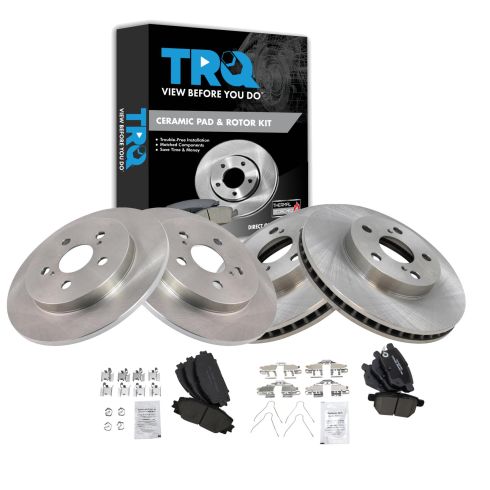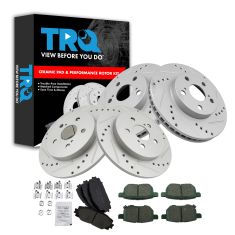1ABFS03392-Toyota Lexus Front & Rear Ceramic Brake Pad & Rotor Kit TRQ BKA27420

Replaces
2014 Toyota Prius Plug-In Front & Rear Ceramic Brake Pad & Rotor Kit TRQ BKA27420

Product Reviews
Loading reviews
5.00/ 5.0
30
30 reviews
great product
March 12, 2019
I have purchased brakes from 1aauto for all kinds of cars and just like all of those these brakes are of great quality. I recommend them to everyone
Easy installation
January 8, 2020
I ordered a set of front rotors and pads for my daughters Toyota Prius C. The quality of the parts was good and the installation was quick and easy. I originally ordered the wrong components and 1AAutos customer service was superb in sending out replacement parts. I will order from them again.
February 3, 2020
Perfect fit for a 2012 Prius 4
Great Products at a Great Price
May 19, 2020
A shop had quoted me $600 to change my brake pads and rotors. I ordered these and took them to another shop to install and ended up saving about $300! Go Economy!
this is the parts store
August 8, 2020
After watching their videos to help me DIY, I bought the parts foe my prius and saved over $300 on parts and roughly around $400 on labor.
Lexus CT200h Front & Rear Ceramic Brake Pad & Rotor Kit
September 11, 2020
Great quality product! Will definitely return to purchase another set.
Good product
December 14, 2020
Thats product was really good, easy to fit and working in good condition
Solid breaks
January 18, 2021
Nice set of breaks, no issues on the installation. Took them to a local shop to have them installed.
Best in the world
February 1, 2021
When I ordered everything it came in days. Parts are high quality and in stall videos where the biggest help. I also use your videos to educate me on my car. The parts are excellent.
Thank You,
Greg R.
Great product at a great price!
March 21, 2021
This kit was perfect for my car. It is a fantastic value when compared to the local car part stores. Comes with all the clips and everything necessary to install. Car rides so smooth now. Will order from you again in the future. Thanks 1A Auto!
Perfect!
March 27, 2021
I did a complete brake job on my Prius with the parts provided from 1A Auto. Perfect fit and saved myself about $600 over a dealer brake job. Keep it up 1A!! Thanks!
Worked great!
June 1, 2021
This was the complete packageeverything I needed to get the job done. I was impressed with the step-by-step video. I will buy more from 1A Auto.
Always meeting my expectations!
July 26, 2021
1A hasn't let me down on any of my multiple purchases. Easy to follow videos are in my "go to" list.
Great do-it-yourself videos to assist with installation
October 3, 2021
High quality parts with all mounting hardware included. What really makes 1A Auto stand above the other companies are the great do-it-yourself videos - this saved me from a potential disaster as I hadnt known about disconnecting the negative battery lead before replacing Prius brake pads and rotors; also provided great tips on removing brake cable (14mm boxend socket) and returning rear piston via turning rather than compressing.
Very satisfied.
October 13, 2021
Every thing I needed including video.
January 24, 2022
As expected.
Worked for me
February 1, 2022
Parts fit the car, half the price.
Great brakes kit!
April 2, 2022
Great deal and excellent quality.
2010 Prius Brakes Front and Back
May 7, 2022
All parts seem to be good quality. Clip/spring hardware included in the kit was helpful to have. All parts fit. Thanks for the install videos. Good price.
Fits great, looks great, easy installation
June 7, 2022
Great fit and easy installation thanks to the 1A Auto YouTube installation video. Looking forward to doing more business in the future
Absolutely outstanding
June 11, 2022
Perfect fit!!
September 2, 2022
Perfect fit. No issues.
Front and rear brakes
November 7, 2022
Fit great thank you
Big savings from what the Dealer wanted.
November 14, 2022
Everything was great. It saved my daughter $450 from what the dealer wanted to just change the pads. I was able to change the rotors and the pads.
March 1, 2023
They were the perfect product. Direct fit, would recommend getting these for your car
Great value. Good quality parts.
May 2, 2023
Great value. Good quality parts.
It fit
May 23, 2023
Perfect fit... quick shipping
Good
July 15, 2023
Good ones
September 12, 2023
Good product
Came quickly
Fit exactly
Nice
March 19, 2024
Fast and good service. Perfect fit and great prices.
Customer Q&A
Is this fit 2015 toyota prius v3?
May 24, 2022
10
This part will not fit your vehicle, but we may have a part that is listed to fit.
Please enter your vehicle's year make and model in the search bar at the top of the page. This will display parts guaranteed to fit your vehicle. Just be sure to verify all of the information shown in the Vehicle Fit tab before ordering.
May 24, 2022
Jessica D
Toyota is a registered trademark of Toyota Motor Corporation. 1A Auto is not affiliated with or sponsored by Toyota or Toyota Motor Corporation.
See all trademarks.

















